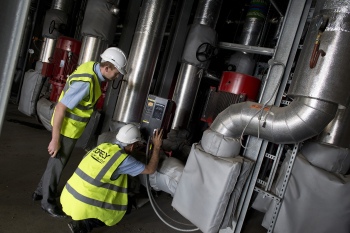Watching the elephants in district energy

District energy schemes have the potential to deliver carbon and economic savings in areas of high energy density but it’s vital to keep an eye on the elephants in the room. Ben Watts of Cofely explains
The number of new district-energy schemes in the UK is increasing, and the industry is showing increasing flexibility and maturity — with different ownership models and more competition. The UK Government is showing commitment in this area through the provision of development expertise and funding via DECC’s Heat Network Delivery Unit. Working groups involving many stakeholders are preparing technical standards, consumer protection protocols and standard forms of contact, all in support of this ambition.
It is therefore tempting to conclude that we are on the right track and that things will continue to improve without further intervention. However, there are still two large elephants in this particular room — capital investment and carbon intensity.
In respect of capital investment, district-energy schemes that can affect genuine transformational change within a city, require long-term financial and fiscal public-sector commitment.
In the UK, city-centre district-energy schemes built in the last decade have tended to be financed via the private sector, using the security of long-term supply agreements (often with the public sector) to underpin capital investment, with limited fiscal or capital support. Examples can be found in cities such as Leicester, Coventry and Birmingham.
Incremental growth of such schemes beyond core public-sector buildings does occur, and the Southampton District Energy Scheme demonstrates what can be achieved, with a diverse range of public and private consumers across a large part of the city centre. However, this penetration takes time (almost three decades in the case of Southampton), so such growth must be accelerated.
In the past, capital grants such as those from the Homes & Communities Agency (HCA) and Energy Saving Trust (EST) have stimulated such expansion. In coming years ERDF (European Regional Development Fund) funding may assist some cities to take further advantage of district energy, but further financial support is required. This could be as soft loans or patient capital, with the public sector providing funding which is drawn down now and repaid through future growth.
The second elephant is carbon intensity.
A key argument often used in favour of district energy from a policy perspective is the use of renewable thermal energy and secondary (waste) heat. However, their wider deployment and success depends on the design, operation and management of the connected building systems.

This largely relates to operating temperatures, which have a direct impact on the types of renewable energy that can be deployed. The lower the operating temperature, the longer the list of renewable and secondary heat sources available — ranging from bioenergy, condensing heat recovery, geothermal, industrial waste heat, solar thermal collectors and sewage heat recovery.
Heat pumps can raise the temperature of low-grade heat but the more work required by the heat pump the lower the net benefit. One further benefit of reducing operating temperatures is to reduce network distribution losses. The lower the operating temperature (especially the return temperature) of the scheme, the greater the carbon savings that can be achieved by the overall system.
There are schemes across Europe that maximise the use of process waste heat, solar-thermal collectors, flue-gas heat recovery, biomass and, in some cases, wind (with excess generation used in electric boilers), but these are generally characterised by low operating temperatures, with building heating systems designed for 65°C flow and 35°C return.
Additional benefits can also be achieved through intelligent demand management, reducing peaks in demand to enable baseload or intermittent low-carbon plant to meet a greater proportion of the total load. This is done at the district scale in Coventry by Cofely, where a thermal accumulator will be used to maximise the use of heat from the local energy-from-waste plant. Work is also starting in UK cities in the area of smart metering and local demand management at the building level. An exciting area of research, but again delivery is needed soon.
There is also a direct link to commercial viability, as the lower the temperature and the greater the ability to manage demand, the more useful energy can be extracted from renewable energy or secondary heat asset, making it a better investable proposition.
In the UK, building heating systems are rarely designed or operated around a low-temperature strategy or with smart load-management systems, but this will be essential if district-heating schemes are to support the UK’s commitments around renewable and low carbon heat. The current momentum in the district energy sector is positive, but we mustn’t take our eyes off the elephants!
Ben Watts is technical development director at Cofely UK








